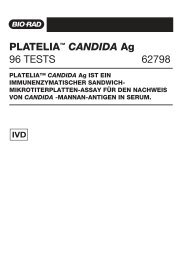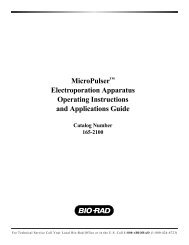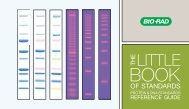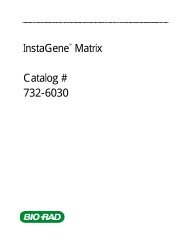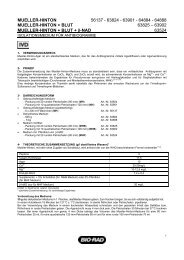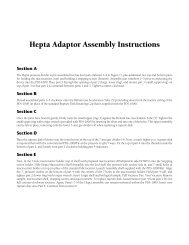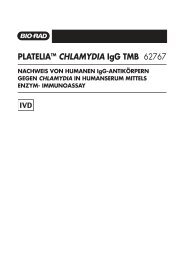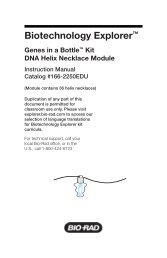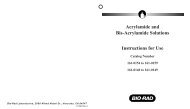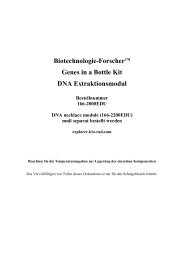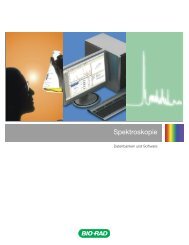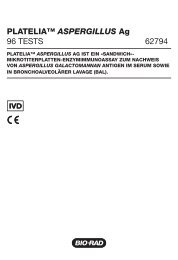- Page 1:
Biotechnology Explorer TM Protein E
- Page 4 and 5:
Protein Expression and Purification
- Page 6 and 7:
Protein Expression and Purification
- Page 8 and 9:
Protein Expression and Purification
- Page 10 and 11:
Protein Expression and Purification
- Page 12 and 13:
Protein Expression and Purification
- Page 14 and 15:
Protein Expression and Purification
- Page 16 and 17:
Protein Expression and Purification
- Page 18 and 19:
Protein Expression and Purification
- Page 20 and 21:
Protein Expression and Purification
- Page 22 and 23:
Protein Expression and Purification
- Page 24 and 25:
Protein Expression and Purification
- Page 26 and 27:
Protein Expression and Purification
- Page 28 and 29:
Protein Expression and Purification
- Page 30 and 31:
Protein Expression and Purification
- Page 32 and 33:
Protein Expression and Purification
- Page 34 and 35:
CHAPTER 1 BACKGROUND Protein Expres
- Page 36 and 37:
CHAPTER 1 BACKGROUND Protein Expres
- Page 38 and 39:
CHAPTER 1 BACKGROUND Protein Expres
- Page 40 and 41:
CHAPTER 1 BACKGROUND Protein Expres
- Page 42 and 43:
CHAPTER 1 BACKGROUND Protein Expres
- Page 44 and 45:
CHAPTER 1 BACKGROUND Protein Expres
- Page 46 and 47:
CHAPTER 1 BACKGROUND Protein Expres
- Page 48 and 49:
CHAPTER 1 BACKGROUND Protein Expres
- Page 50 and 51:
CHAPTER 2 FOCUS QUESTIONS Protein E
- Page 52 and 53:
CHAPTER 2 FOCUS QUESTIONS Protein E
- Page 54 and 55:
CHAPTER 2 FOCUS QUESTIONS Protein E
- Page 56 and 57:
CHAPTER 3A ADVANCE PREP CENTRIFUGAT
- Page 58 and 59:
CHAPTER 3A ADVANCE PREP CENTRIFUGAT
- Page 60 and 61:
CHAPTER 3A ADVANCE PREP CENTRIFUGAT
- Page 62 and 63:
CHAPTER 3A ADVANCE PREP CENTRIFUGAT
- Page 64 and 65:
CHAPTER 3A ADVANCE PREP CENTRIFUGAT
- Page 66 and 67:
CHAPTER 3A ADVANCE PREP CENTRIFUGAT
- Page 68 and 69:
CHAPTER 3A ADVANCE PREP CENTRIFUGAT
- Page 70 and 71:
CHAPTER 3A ADVANCE PREP CENTRIFUGAT
- Page 72 and 73:
CHAPTER 3B ADVANCE PREP INSTRUMENTA
- Page 74 and 75:
CHAPTER 3B ADVANCE PREP INSTRUMENTA
- Page 76 and 77:
CHAPTER 3B ADVANCE PREP INSTRUMENTA
- Page 78 and 79:
CHAPTER 3B ADVANCE PREP INSTRUMENTA
- Page 80 and 81:
CHAPTER 3B ADVANCE PREP INSTRUMENTA
- Page 82 and 83:
CHAPTER 3B ADVANCE PREP INSTRUMENTA
- Page 84 and 85:
CHAPTER 3B ADVANCE PREP INSTRUMENTA
- Page 86 and 87:
CHAPTER 3B ADVANCE PREP INSTRUMENTA
- Page 88 and 89:
CHAPTER 3B ADVANCE PREP INSTRUMENTA
- Page 90 and 91:
CHAPTER 3B ADVANCE PREP INSTRUMENTA
- Page 92 and 93:
CHAPTER 4 11 ml CULTURE PROTOCOL Pr
- Page 94 and 95:
CHAPTER 4 11 ml CULTURE PROTOCOL Pr
- Page 96 and 97:
CHAPTER 4 11 ml CULTURE PROTOCOL Pr
- Page 98 and 99:
CHAPTER 4 11 ml CULTURE PROTOCOL Pr
- Page 100 and 101:
CHAPTER 4 11 ml CULTURE PROTOCOL Pr
- Page 102 and 103:
CHAPTER 4 11 ml CULTURE PROTOCOL Pr
- Page 104 and 105:
CHAPTER 4 11 ml CULTURE PROTOCOL Pr
- Page 106 and 107:
CHAPTER 4 11 ml CULTURE PROTOCOL Pr
- Page 108 and 109:
CHAPTER 4 11 ml CULTURE PROTOCOL Pr
- Page 110 and 111:
CHAPTER 4 11 ml CULTURE PROTOCOL Pr
- Page 112 and 113:
CHAPTER 4 11 ml CULTURE PROTOCOL Pr
- Page 114 and 115:
CHAPTER 4 11 ml CULTURE PROTOCOL Pr
- Page 116 and 117:
CHAPTER 4 11 ml CULTURE PROTOCOL Pr
- Page 118 and 119:
CHAPTER 5 100 ml CULTURE PROTOCOL P
- Page 120 and 121:
CHAPTER 5 100 ml CULTURE PROTOCOL P
- Page 122 and 123:
CHAPTER 5 100 ml CULTURE PROTOCOL P
- Page 124 and 125:
CHAPTER 5 100 ml CULTURE PROTOCOL P
- Page 126 and 127:
CHAPTER 5 100 ml CULTURE PROTOCOL P
- Page 128 and 129:
CHAPTER 5 100 ml CULTURE PROTOCOL P
- Page 130 and 131:
CHAPTER 5 100 ml CULTURE PROTOCOL P
- Page 132 and 133:
CHAPTER 5 100 ml CULTURE PROTOCOL P
- Page 134 and 135:
CHAPTER 6 HANDPACKING COLUMNs Prote
- Page 136 and 137:
CHAPTER 6 HANDPACKING COLUMNs Prote
- Page 138 and 139:
CHAPTER 6 HANDPACKING COLUMNs Prote
- Page 140 and 141:
CHAPTER 7 BIOLOGIC LP SYSTEM PROTOC
- Page 142 and 143:
CHAPTER 7 BIOLOGIC LP SYSTEM PROTOC
- Page 144 and 145:
CHAPTER 7 BIOLOGIC LP SYSTEM PROTOC
- Page 146 and 147:
CHAPTER 7 BIOLOGIC LP SYSTEM PROTOC
- Page 148 and 149:
CHAPTER 7 BIOLOGIC LP SYSTEM PROTOC
- Page 150 and 151:
CHAPTER 7 BIOLOGIC LP SYSTEM PROTOC
- Page 152 and 153:
CHAPTER 7 BIOLOGIC LP SYSTEM PROTOC
- Page 154 and 155:
CHAPTER 7 BIOLOGIC LP SYSTEM PROTOC
- Page 156 and 157:
CHAPTER 7 BIOLOGIC LP SYSTEM PROTOC
- Page 158 and 159:
CHAPTER 7 BIOLOGIC LP SYSTEM PROTOC
- Page 160 and 161:
CHAPTER 7 BIOLOGIC LP SYSTEM PROTOC
- Page 162 and 163:
CHAPTER 7 BIOLOGIC LP SYSTEM PROTOC
- Page 164 and 165:
CHAPTER 7 BIOLOGIC LP SYSTEM PROTOC
- Page 166 and 167:
CHAPTER 8 BIOLOGIC DUOFLOW PROTOCOL
- Page 168 and 169:
CHAPTER 8 BIOLOGIC DUOFLOW PROTOCOL
- Page 170 and 171:
CHAPTER 8 BIOLOGIC DUOFLOW PROTOCOL
- Page 172 and 173:
CHAPTER 8 BIOLOGIC DUOFLOW PROTOCOL
- Page 174 and 175:
CHAPTER 8 BIOLOGIC DUOFLOW PROTOCOL
- Page 176 and 177:
CHAPTER 8 BIOLOGIC DUOFLOW PROTOCOL
- Page 178 and 179:
CHAPTER 8 BIOLOGIC DUOFLOW PROTOCOL
- Page 180 and 181:
CHAPTER 8 BIOLOGIC DUOFLOW PROTOCOL
- Page 182 and 183:
CHAPTER 8 BIOLOGIC DUOFLOW PROTOCOL
- Page 184 and 185:
CHAPTER 8 BIOLOGIC DUOFLOW PROTOCOL
- Page 186 and 187: CHAPTER 8 BIOLOGIC DUOFLOW PROTOCOL
- Page 188 and 189: CHAPTER 8 BIOLOGIC DUOFLOW PROTOCOL
- Page 190 and 191: CHAPTER 8 BIOLOGIC DUOFLOW PROTOCOL
- Page 192 and 193: CHAPTER 8 BIOLOGIC DUOFLOW PROTOCOL
- Page 194 and 195: CHAPTER 8 BIOLOGIC DUOFLOW PROTOCOL
- Page 196 and 197: CHAPTER 8 BIOLOGIC DUOFLOW PROTOCOL
- Page 198 and 199: CHAPTER 8 BIOLOGIC DUOFLOW PROTOCOL
- Page 200 and 201: CHAPTER 8 BIOLOGIC DUOFLOW PROTOCOL
- Page 202 and 203: CHAPTER 9 DHFR ENZYMATIC ASSAY Prot
- Page 204 and 205: CHAPTER 9 DHFR ENZYMATIC ASSAY Prot
- Page 206 and 207: CHAPTER 9 DHFR ENZYMATIC ASSAY Prot
- Page 208 and 209: CHAPTER 9 DHFR ENZYMATIC ASSAY Prot
- Page 210 and 211: APPENDIX A TIPS AND HELPFUL HINTS P
- Page 212 and 213: APPENDIX A TIPS AND HELPFUL HINTS P
- Page 214 and 215: APPENDIX B RESULTS ANALYSIS Protein
- Page 216 and 217: APPENDIX B RESULTS ANALYSIS Protein
- Page 218 and 219: APPENDIX C RCF TO RPM CONVERSTION P
- Page 220 and 221: APPENDIX D SETTING UP THE SMARTSPEC
- Page 222 and 223: APPENDIX D SETTING UP THE SMARTSPEC
- Page 224 and 225: APPENDIX E MINI-PROTEAN GEL BOX SET
- Page 226 and 227: APPENDIX F BIOLOGIC LP SYSTEM SETUP
- Page 228 and 229: APPENDIX F BIOLOGIC LP SYSTEM SETUP
- Page 230 and 231: APPENDIX G BIOMANUFACTURING Protein
- Page 232 and 233: APPENDIX G BIOMANUFACTURING Protein
- Page 234 and 235: APPENDIX H FOCUS QUESTIONS INSTRUCT
- Page 238 and 239: APPENDIX H FOCUS QUESTIONS INSTRUCT
- Page 240 and 241: APPENDIX H FOCUS QUESTIONS INSTRUCT
- Page 242 and 243: APPENDIX I GLOSSARY Protein Express
- Page 244 and 245: APPENDIX I GLOSSARY Protein Express
- Page 246 and 247: APPENDIX J REFERENCES, LEGAL NOTES
- Page 250: Life Science Group Bulletin 1665067




